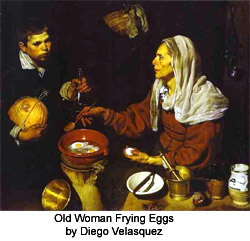Diego Velázquez
Diego Vel zquez
Reading Comprehension for June 6
In the early seventeenth century, a young boy named Diego loved to watch his mother cook eggs. He liked the way the slimy, clear liquid slowly turned white and rubbery from the heat. Later, this boy became a great artist. He painted Old Woman Frying Eggs, and the picture looked so real that you could almost smell breakfast. Diego Velázquez became famous for his realistic paintings.
Diego Velázquez was born in Seville, Spain, in June 1599. His family was wealthy, but not much is known about his childhood because he lived so long ago. People in the 17th century started training for their jobs when they were quite young. Diego's father arranged for the boy to study with a local artist named Francisco de Herrera.
Diego's father liked his young son's teacher, but when Diego was 12, Diego's father thought he needed to study with someone new. Diego became an apprentice to Francisco Pacheco. Pacheco did not have much flare and excitement in his paintings, but he did teach his young student to paint with realism. Velázquez stayed with him for five years and learned about perspective, proportion, and balance. As a teenager, he also fell in love with Pacheco's daughter and married her when he was just nineteen. His teacher was thrilled that his brilliant student had become his son-in-law.
Diego easily became a member of the painters' guild of St. Luke in Seville. All artists had to be accepted into this guild so that they could start their own workshops and get jobs from churches and the government. Velázquez built his business and his family at the same time. Soon, he had two daughters, but only one survived.
Diego painted common subjects, like pots, eggs, and kitchen scenes. Old Woman Frying Eggs became one of his most famous pictures. The woman has a white scarf on her head that looks as though it could be plucked right out of the painting. The eggs in a pan are just starting to cook, and their whites are part solid, part liquid. These pictures of everyday things were called bodegones. This word comes from the word "bodegon," which was a cheap place to eat.




